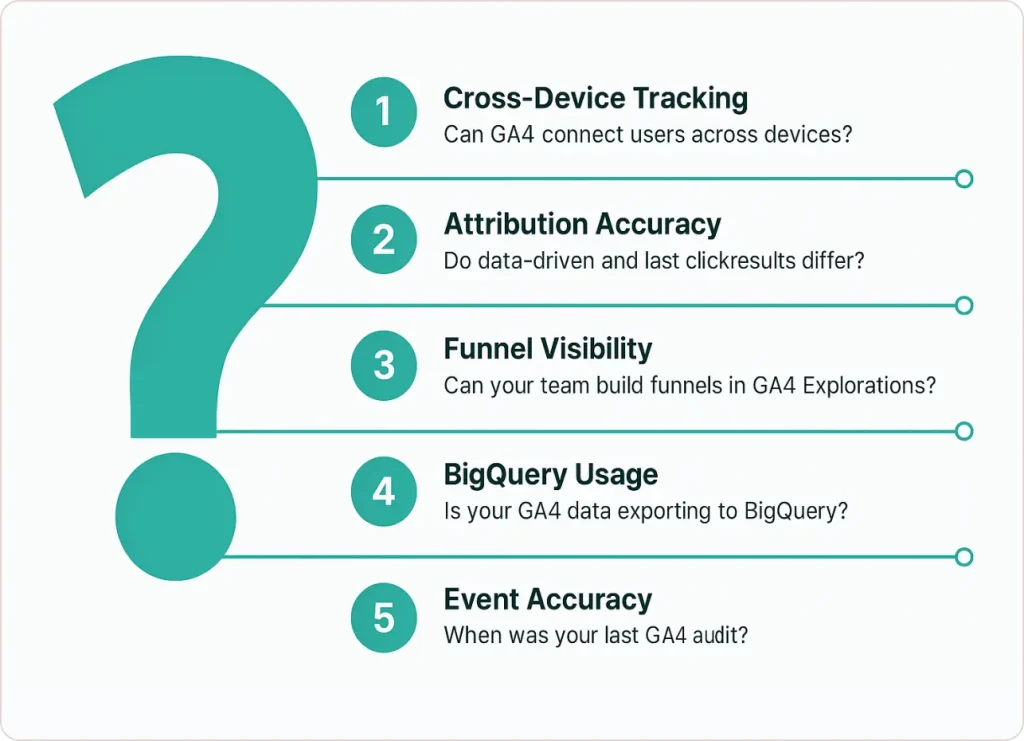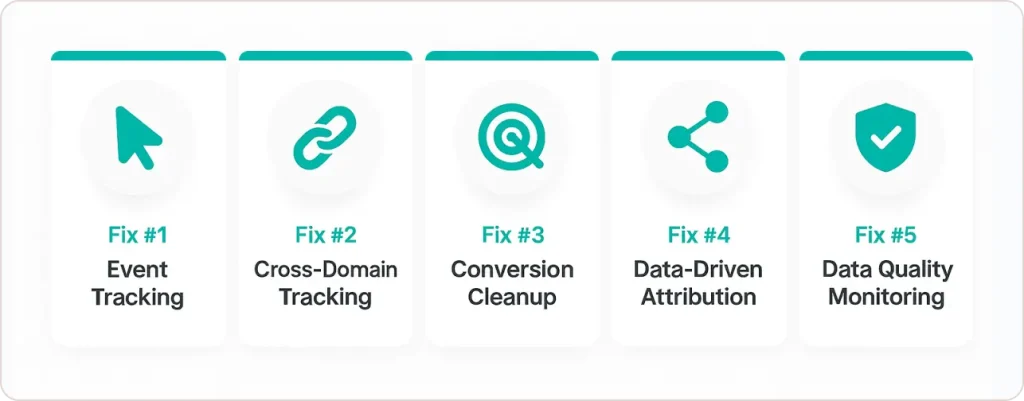Key Highlights
- Five diagnostic questions reveal GA4 implementation health immediately
- Missing event tracking creates 30-50% blind spots in user behavior
- Broken cross-domain measurement fragments customer journey visibility
- Misconfigured attribution systematically misallocates marketing budgets
- BigQuery disconnection wastes GA4’s most powerful analytical capability
The $2 Million Problem Hiding in Your Analytics
“Your GA4 is probably broken, here’s how to know in 5 minutes.”
It’s October 2025. Your marketing team just reported that organic search drives 60% of conversions. Your CFO approved a $500K SEO investment based on that data.
Here’s the problem: your GA4 is probably lying to you.
After auditing 200+ GA4 implementations at SR Analytics over the past year, I can tell you with certainty: if your setup was rushed during the 2023 Universal Analytics migration, there’s an 81% chance you’re making business decisions based on fundamentally broken data.
Not “slightly misconfigured.” Broken.
Missing critical events. Attribution pointing at wrong channels. Cross-device tracking that doesn’t track across devices. E-commerce funnels with gaps that hide where customers actually abandon.
The business cost? A manufacturing client discovered their GA4 was missing 47% of lead form submissions. For 14 months, they’d been underinvesting in their highest-performing channel because the data said it wasn’t working.
This isn’t another “what changed in GA4” article. This is the diagnostic every CTO, CMO, and CFO needs: how to know if YOUR GA4 is working, and what to do if it’s not.
The 5-Question GA4 Health Check

Answer these five questions. If you can’t answer confidently, or your team hesitates, you have a GA4 problem costing you money right now.
Question 1: “Show me our complete customer journey from first touch to conversion across devices”
What this tests: Cross-device tracking and attribution configuration
Why it matters: If GA4 can’t connect a user who discovers you on mobile, researches on tablet, and converts on desktop, you’re seeing three separate “users” instead of one customer journey. Your attribution model is therefore fiction.
How to check: Go to Reports → Life Cycle → Acquisition → User Acquisition. Click any traffic source. Can you see “Cross-platform” data? Do the user counts look realistic, or suspiciously high (suggesting double-counting)?
Red flags:
- “Direct traffic” is your #1 source (usually means cross-domain tracking is broken)
- User counts jumped 40%+ after switching from UA (double-counting across devices)
- No “Google Signals” data in reports (means cross-device feature isn’t enabled)
What’s broken if you can’t answer: User ID not implemented, Google Signals not enabled, or cross-domain measurement not configured. Result: your attribution model credits the wrong channels, and you’re misallocating budget.
Question 2: “What’s our data-driven attribution showing vs. last-click for our top 5 channels?”
What this tests: Whether you’re using GA4’s most valuable feature or defaulting to outdated methodology
Why it matters: Last-click attribution systematically undervalues upper-funnel activities (content, social, display) and overvalues bottom-funnel activities (branded search, direct). You’ll defund the channels that generate demand and overfund the ones that just capture existing demand.
How to check: Go to Advertising → Attribution → Model Comparison. Compare “Data-driven” vs. “Last click.” If the numbers are identical or the report is empty, attribution isn’t working.
Red flags:
- Can’t find the Model Comparison report
- Data-driven and last-click show identical results
- Report says “not enough data” (means conversions aren’t properly configured)
What’s broken if you can’t answer: Conversions not marked as key events, Google Ads not linked, or insufficient conversion volume for modeling. Result: you’re still using 2015 methodology to allocate 2025 budgets.
Question 3: “Build me a funnel showing where users drop off in our key conversion path, segmented by traffic source”
What this tests: Whether your team knows how to use GA4 Explorations, the platform’s most powerful feature
Why it matters: GA4’s default reports are deliberately minimal. The real insights come from custom Explorations (funnels, path analysis, cohorts). If your team can’t build these in 10 minutes, you’re getting 20% of GA4’s value.
How to check: Ask your analytics manager to open Explore → Funnel Exploration and build a custom funnel for your key conversion path. Can they do it without Googling instructions?
Red flags:
- Team doesn’t know what “Explorations” are
- Takes 30+ minutes to build a simple funnel
- Can’t add segments or breakdowns to analysis
What’s broken if you can’t answer: Training gap, not a technical issue. But the business impact is the same: you’re not discovering optimization opportunities that are sitting in your data.
Question 4: “What percentage of our events are exporting to BigQuery, and what analysis are we running?”
What this tests: Whether you’re leveraging GA4’s most advanced capability
Why it matters: BigQuery export (free in GA4, was $150K/year in UA 360) lets you join analytics data with CRM, product, and sales data to answer questions GA4’s interface can’t. Questions like: “What’s true customer LTV by acquisition channel?” or “Which onboarding paths predict 90-day retention?”
How to check: Go to Admin → Data Streams → Select your web stream → Check if BigQuery is connected. If yes, ask what queries you’re running. If no one knows, you’re not using it.
Red flags:
- “We enabled it but haven’t used it”
- No one on team knows SQL or has BigQuery access
- Not connected at all
What’s broken if you can’t answer: Either not configured (opportunity cost) or configured but unused (expertise gap). Result: you’re limited to surface-level analysis when your competitors are running deep behavioral modeling.
Question 5: “How do we know our event tracking is accurate and complete?”
What this tests: Data quality processes and audit discipline
Why it matters: GA4 won’t tell you when tracking breaks. If a developer accidentally removes a tracking code, or a form changes and events stop firing, you’ll keep seeing data, just wrong data. Without regular audits, you won’t know.
How to check: Ask when the last GA4 audit happened. Can they show you documentation of what was checked? Do they have a data quality monitoring process?
Red flags:
- “We set it up in 2023 and haven’t checked since”
- No audit checklist or quality assurance process
- Can’t explain how they verify event accuracy
What’s broken if you can’t answer: No quality control, which means accumulated drift over 3 years. Events are probably misconfigured, firing incorrectly, or missing entirely.
The 5 Critical Gaps Costing You Money
Based on auditing 200+ implementations, these are the exact issues destroying data accuracy in most GA4 setups, and their business impact.
Gap #1: Missing Event Tracking (Found in 73% of Audits)
What’s broken: GA4 auto-collects pageviews and basic interactions, but critical business events require custom configuration. Most companies never set these up.
Common missing events:
- Form submissions (lead capture, contact forms, newsletter signups)
- File downloads (whitepapers, case studies, product sheets)
- Video engagement (play, 25/50/75% watched, complete)
- Scroll depth (25%, 50%, 75%, 90%)
- Button clicks (CTA, social share, phone number)
- Product interactions (quick view, size chart, compare)
Business impact example: A SaaS company’s GA4 showed 2,000 monthly “engaged sessions” on their pricing page. After implementing proper event tracking, we discovered only 400 actually clicked “Start Free Trial,” and 200 of those clicked multiple times (indicating confusion). The page wasn’t performing, it was broken. They redesigned it and trials increased 34%.
Why this happens: GA4’s automatic event tracking is minimal. Unlike Universal Analytics (which had more defaults), GA4 expects you to define what matters to YOUR business. Companies who migrated quickly often just turned on auto-tracking and called it done.
How to check: Go to Reports → Engagement → Events. If you only see: page_view, session_start, first_visit, user_engagement, you’re missing most of what matters.
Gap #2: Broken Cross-Domain Tracking (Found in 68% of Audits)
What’s broken: If your business operates across multiple domains (marketing site, blog, web app, checkout subdomain), GA4 must be configured to recognize these as one property. Otherwise, users moving between domains look like new visitors each time.
Common scenarios:
- Main site: yourcompany.com
- Blog: blog.yourcompany.com
- Product: app.yourcompany.com
- Checkout: checkout.yourcompany.com
Without cross-domain setup, a user’s journey breaks at every domain change. They’re counted as 4 separate users making 4 separate sessions.
Business impact example: An e-commerce company’s GA4 showed 40% of conversions came from “Direct traffic” (meaning: no known source). After fixing cross-domain tracking, we discovered 60% of those were actually from paid ads, the tracking just broke when users clicked from an ad on “shop.domain.com” to checkout on “secure.domain.com.” They’d been underfunding their best-performing channel for 18 months.
Why this happens: Cross-domain measurement requires manual configuration (adding domains to a list in GA4 settings, modifying tracking code). It’s easy to miss during migration, especially if UA had it set up differently.
How to check: Go to Admin → Data Streams → Web → Configure tag settings → Configure your domains. Is every domain/subdomain listed? If not, tracking breaks at domain boundaries.
Gap #3: Misconfigured or Missing Conversions (Found in 71% of Audits)
What’s broken: In Universal Analytics, you created “Goals.” In GA4, you mark any event as a “Key Event” (formerly called “Conversion”). Many companies either:
- Marked nothing (no conversions at all)
- Marked everything (making data meaningless)
- Marked the wrong events (tracking “page_view” as a conversion)
What should be marked as conversions:
- Macro-conversions: purchases, lead forms, demo requests, trial signups
- Micro-conversions (if predictive): video watched, pricing viewed, comparison tool used
Business impact example: A healthcare company marked 18 different events as conversions, including “scroll” and “page_view.” Their conversion rate was 94%, which executives knew was nonsense but didn’t know how to fix. After cleaning up (marking only appointment requests as conversions), the real rate was 3.2%, and they finally had reliable data to optimize against.
Why this happens: GA4’s flexibility is confusing. UA had 20-goal limits and clear types (destination, event, duration). GA4 says “mark whatever matters”, and teams either overthink it or ignore it.
How to check: Go to Admin → Events → Look for “Mark as key event” toggle. Are your actual business conversions marked? Click into Reports → Engagement → Conversions. Do the numbers make sense?
Gap #4: Attribution Model Still Using Last-Click (Found in 64% of Audits)
What’s broken: GA4 defaults to data-driven attribution, which fractionally credits every touchpoint based on machine learning. But if Google Ads isn’t linked, or conversion volume is too low, it falls back to last-click (the worst attribution model).
Why last-click is broken: It credits whichever channel the user touched immediately before converting. This systematically:
- Undervalues awareness channels (social, display, content)
- Overvalues direct and branded search
- Hides the actual customer journey
Business impact example: A B2B company’s last-click attribution showed email driving 55% of demo requests. They doubled the email budget. After switching to data-driven attribution, we revealed the actual pattern: LinkedIn ads (awareness) → blog content (consideration) → email (conversion trigger). LinkedIn was the highest-value channel, but last-click gave it 8% credit. They reallocated budget and demos increased 37% while CAC dropped 23%.
Why this happens: Data-driven attribution requires Google Ads linking and sufficient conversion volume (roughly 400 conversions per month minimum). Many companies don’t meet thresholds or never link their accounts.
How to check: Go to Advertising → Attribution → Conversion paths. Can you see multiple touchpoints? If every conversion shows 1 touchpoint, you’re on last-click. Go to Admin → Attribution settings to verify the model.
Gap #5: No Data Quality Monitoring (Found in 89% of Audits)
What’s broken: GA4 doesn’t alert you when tracking breaks. If someone changes website code, updates forms, or modifies button IDs, events silently stop firing. You keep seeing data, just incomplete data.
Common silent failures:
- Form submission events stop after form redesign
- E-commerce tracking breaks after checkout update
- Events fire multiple times (inflating numbers)
- Events fire on wrong pages (contaminating data)
- Bot traffic counted as real users
- Internal team traffic not excluded
Business impact example: A manufacturing company noticed conversion rates dropped 30% over 3 months. They assumed market conditions changed and shifted strategy. After the audit, we discovered their contact form events stopped firing when they updated the form in May, they’d been flying blind for 90 days, making decisions based on zero actual data.
Why this happens: No one is responsible for ongoing monitoring. GA4 was “set up” once in 2023, then forgotten. Development teams make site changes without consulting analytics teams. Drift accumulates.
How to check: When was your last GA4 audit? Do you have a QA checklist? Do developers consult with analytics before deploying changes? If answers are “never,” “no,” and “no,” you have drift.
How to Fix Each Gap (Tactical Guidance)

Fix #1: Implement Missing Event Tracking
DIY approach (if you have technical resources):
- Audit what’s missing: List every user action that indicates intent or engagement (form submits, downloads, video plays, CTA clicks)
- Prioritize by business impact: Start with conversion-adjacent events (pricing page views, trial button clicks, checkout steps)
- Configure in Google Tag Manager: For each event, create triggers and tags (if using GTM) or update on-page tracking code. Google’s Tag Manager documentation provides detailed setup instructions for common event types.
- Test thoroughly: Use GA4 DebugView (Admin → DebugView) to verify events fire correctly before deploying
- Document everything: Create a tracking specification so future developers know what’s instrumented
When to hire help: If your team doesn’t know Google Tag Manager, isn’t comfortable with JavaScript, or you need this done in days not weeks, bring in specialists. A professional implementation takes 2-4 weeks and costs $3K-8K depending on complexity, but the ROI of accurate data is immediate.
Fix #2: Configure Cross-Domain Tracking
DIY approach:
- List all domains/subdomains: Include www vs non-www, any microsites, blog subdomains, checkout domains
- Add to GA4: Admin → Data Streams → Configure tag settings → Configure your domains → Add all domains
- Update tracking code: Ensure GA4 tracking code is identical across ALL domains (same Measurement ID)
- Test with GA4 DebugView: Navigate between domains while monitoring DebugView, session should persist
Common mistake: Forgetting subdomains. If you have blog.domain.com and shop.domain.com, both need explicit listing. Google’s cross-domain measurement guide walks through proper configuration steps.
When to hire help: If you have complex domain structures (10+ domains, third-party checkout platforms like Shopify, embedded forms from other domains), experts can configure this in days vs. your team’s weeks of troubleshooting.
Fix #3: Clean Up Conversion Configuration
DIY approach:
- Identify true business conversions: What actions directly indicate business value? (purchases, leads, signups, not pageviews)
- Unmark noise: Go to Admin → Events → Find events incorrectly marked as key events → Turn off toggle
- Mark what matters: For each true conversion, toggle “Mark as key event”
- Verify in reports: Reports → Engagement → Conversions → Numbers should be realistic (not 90%+ conversion rates)
Pro tip: Limit to 5-10 key events maximum. If everything is a conversion, nothing is.
When to hire help: If you’re unsure what SHOULD be a conversion (measurement strategy consulting) or have complex e-commerce with multiple conversion types (purchase, subscribe, download, request quote), strategic guidance ensures you’re measuring what actually predicts revenue.
Fix #4: Switch to Data-Driven Attribution
DIY approach:
- Link Google Ads: Admin → Product links → Google Ads links → Follow prompts (required for cross-platform attribution)
- Verify conversion volume: Need ~400 conversions/month minimum for data-driven model to work
- Enable data-driven attribution: Admin → Attribution settings → Reporting attribution model → Select “Data-driven”
- Compare models: Advertising → Attribution → Model comparison → Compare last-click vs. data-driven to see impact
What if you don’t have enough conversions? Consider “position-based” (40% credit to first and last touch, 20% to middle touches) as a better alternative to last-click. According to attribution research from Ruler Analytics, multi-channel attribution can provide efficiency gains of 15-30% compared to last-click methods.
When to hire help: If attribution data reveals your entire budget allocation is wrong (common), you need strategic guidance on how to reallocate without organizational chaos. Change management around attribution shifts is where consultants add value.
Fix #5: Implement Data Quality Monitoring
DIY approach:
- Create audit checklist: Document every event, conversion, and tracking element
- Schedule quarterly audits: Every 90 days, check that all events still fire correctly, no duplicate events, filters working
- Integrate with development workflow: Require analytics review before any site changes that affect forms, buttons, or checkout
- Set up alerts: Use GA4 custom alerts (Admin → Custom definitions → Create custom metric) to notify when event volume drops 20%+
When to hire help: If you don’t have internal resources for quarterly audits, an annual professional audit ($2K-5K) catches drift before it costs you six figures in a misallocated budget.
Should You Fix This Yourself or Hire Help?
Here’s the honest assessment most consultants won’t give you:
You can probably DIY if:
- You have a dedicated analytics person (not a marketer wearing 5 hats)
- Your tech team knows Google Tag Manager
- Your site is relatively simple (under 50 pages, standard conversion paths)
- You have 4-6 weeks to implement and test
- You’re comfortable with trial and error
You should hire help if:
- Your site is complex (e-commerce, SaaS with multiple products, multi-domain)
- You need this fixed in under 2 weeks (opportunity cost of waiting is high)
- Your team attempted fixes and made things worse
- You want strategic guidance, not just technical implementation
- The cost of wrong data exceeds the cost of expertise ($5K-15K implementation vs. $200K misallocated budget)
The math: A GA4 audit and implementation costs $5K-15K depending on complexity. If broken attribution is causing you to misallocate even 5% of a $500K marketing budget, that’s $25K wasted annually. The ROI of fixing this is typically 3-10x within the first year.
Your Next Steps: The 48-Hour Action Plan
Hour 1-2: Run the diagnostic
- Ask your team the 5 questions from this article
- Document where you can’t answer confidently
- Check your Events report for missing tracking
Hour 3-4: Assess severity
- Score yourself (0-5 on the diagnostic)
- Estimate business impact (what decisions are you making based on this data?)
- Calculate opportunity cost (what’s a misallocated budget costing you?)
Hour 5-8: Decide on approach
- DIY: Assign resources, create timeline, download implementation checklist
- Hire: Request quotes, check references, verify GA4-specific expertise (not just “analytics consulting”)
Within 48 hours: Take action Don’t let this sit in your inbox for 3 months. Broken data costs you money every single day.
The Bottom Line: Your Data Is Either an Asset or a Liability
It’s October 2025. Universal Analytics has been dead for over 3 years. The companies who treated GA4 migration as a checkbox exercise are now making million-dollar decisions based on fundamentally broken data.
The companies who are winning, who are actually using GA4 to drive growth, did three things:
- Audited ruthlessly to find what broke during migration
- Fixed systematically rather than patchwork band-aids
- Monitored continuously to catch drift before it compounds
Your GA4 is either:
- A strategic asset giving you visibility into real customer behavior, enabling optimization, and improving ROI
- A liability generating false confidence in wrong decisions, misallocating budgets, and hiding opportunities
The difference between those outcomes is often a focused 2-4 week implementation project.
If your team couldn’t confidently answer 4+ of the diagnostic questions, or if this article revealed gaps you didn’t know existed, the next step is determining whether your situation requires a quick internal fix or strategic Google Analytics consulting services to ensure accurate data moving forward.
The important thing is to act within 48 hours, not to let this become another “we should look at that someday” item that costs you another quarter of a misallocated budget.














